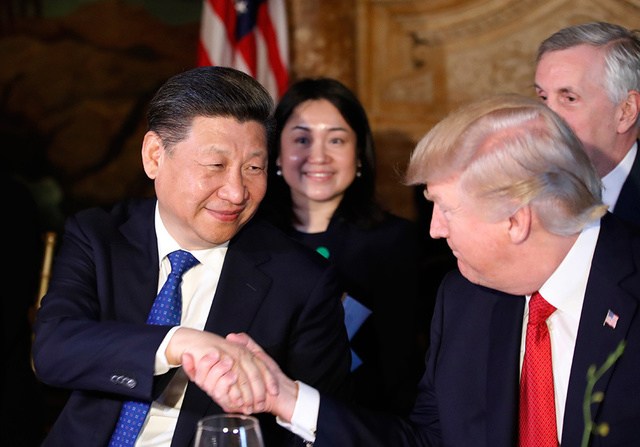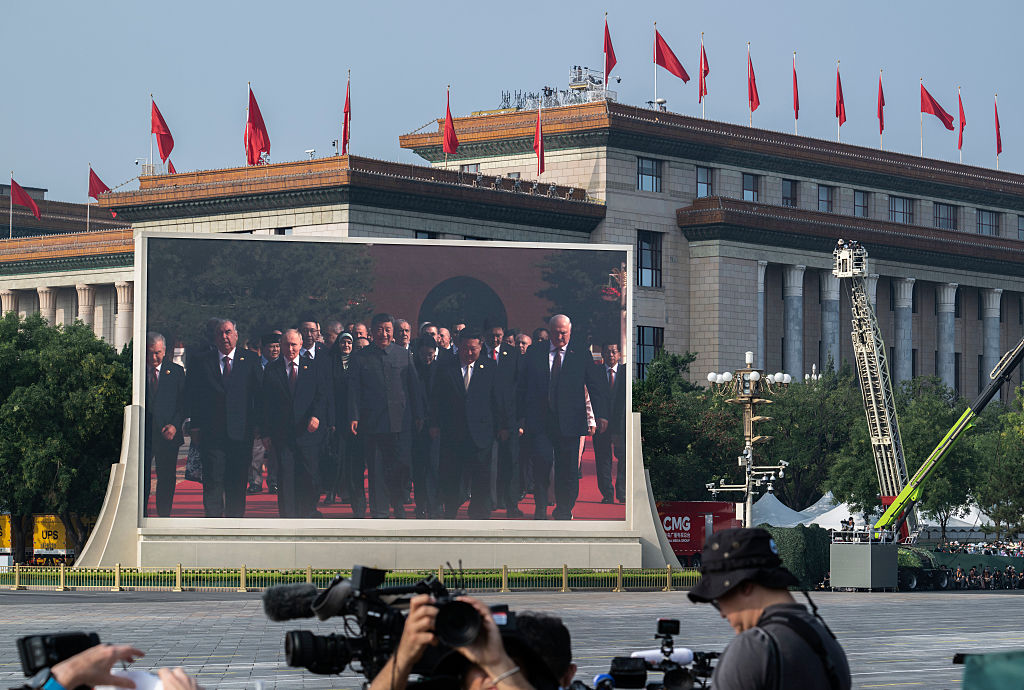
U.S.-China Summits Point to Shift Toward Economic Statecraft
U.S.-China Summits Point to Shift Toward Economic Statecraft
During President Trump’s trip to Beijing and the ASEAN Summit in November 2017, President Trump and President Xi confirmed that the future of U.S.-Chinese relations will focus largely on opportunities for U.S. and Chinese businesses, potential security cooperation, and ongoing points of friction. The ASEAN Summit also solidified China’s intentions to become a regional leader offering a new model of development, and the United States’ focus on domestic economic protection.
Market-Driven Economic Ties
Throughout the course of the two-day meeting, Presidents Trump and Xi concluded $250 billion worth of commercial deals, most of which involve Chinese companies buying U.S. energy, technology, and farm products (Global Times, November 14). The largest of these deals was an agreement from the Chinese state-owned China Energy Investment Corp to invest $83.7 billion in power generation, chemical manufacturing, and underground storage of natural gas liquids and derivatives in West Virginia. Additionally, Sinopec, the Bank of China, and Alaska Gasoline agreed on a major natural gas project worth $43 billion. Other notable deals include a confirmed $37 billion sale of 300 Boeing jets to China Aviation Supplies Holding Company, $12 billion sale of Qualcomm semiconductors to three Chinese mobile companies, and an agreement between Goldman Sachs and Chinese state-owned China Investment Corp. to invest $5 billion in U.S. manufacturing, industrial, consumer and healthcare companies (Caixin, November 9).
Chinese media heralded these deals as a positive step demonstrating President Trump’s commitment to “business over politics,” and lauded Trump as a U.S. president “finally interested in economic interests.” Clearly, the perception in Beijing is that Trump demonstrated a willingness to pursue U.S. commercial business opportunities with China without leveraging broader political or strategic goals to do so. If true, this marks a shift from previous administrations, which have tended to tie shifts in U.S. economic relations with China to wider human rights or geopolitical concerns. Yet other Trump administration officials have dismissed this approach, noting that the commercial deals were largely non-binding memorandums and therefore “nothing new”.
What these deals do raise, however, are questions about how China is reforming to open itself to foreign investments. In the first half of 2017, foreign investment in China fell 1.2 percent, approximately $72 billion, due to stringent regulation and intellectual property theft. In response, China has adopted policies and lifted restrictions that have limited foreign investment in China. For example, in January and August 2017, the Chinese State Council announced that it would improve intellectual property protection and allow foreign investors to freely remit investment gains from the country to maintain foreign investment flows (Gov.cn, January 13; Gov.cn, August 17). In November 2010, China’s Vice Finance Minister Zhu Guangyao also announced that China would start allowing foreign investors to own 51 percent of Chinese security firms, fund managers, and future companies—a substantial increase from the current limits of 25 percent for publicly traded security firms. He also stated that China would increase similar limitations on foreign investment in insurance companies and banks. Yet despite these positive reforms, concerns about Chinese surveillance and commercial espionage continue have had a chilling effect on foreign investment. For example, China still requires all foreign firms to store financial data on Chinese-made and approved telecommunication devices per China’s 2015 cybersecurity laws, opening foreign firms and investors to the risk of intellectual property theft. While the deals concluded during Trump’s meeting clearly illustrate China’s willingness and need to increase ties with foreign businesses, whether China can properly reform its domestic regulations to support foreign investment in China remains unclear.
Increased Security Cooperation and Ongoing Points of Friction
In Beijing, Trump and Xi also emphasized opportunities for U.S.-Chinese cooperation on several ongoing security matters but made little progress in resolving tensions in the East and South China Seas or in dealing with the North Korea issue. During their joint press statement, the leaders highlighted the need for multilateral and bilateral diplomatic and security dialogues, and identified transnational crime and counterterrorism in the Middle East as opportunities for further cooperation (Whitehouse.gov, November 9). The two sides also identified areas for de-escalation and conflict management, such as expanding military-to-military ties with the joint staff dialogue and engaging in disaster management joint exercises. While theoretically these mechanisms can be a useful tool in managing escalation dynamics in the seas and with North Korea, ultimately such discussions do not address the fundamental differences in U.S.-Chinese interests these scenarios.
As such, both leaders remain at an impasse in tackling the issues in the East and South China Seas and North Korea. In Beijing, Xi declared that the Pacific Ocean was “big enough for both China and the United States” and repeated the official Chinese line urging the United States to respect countries’ territorial sovereignty. Xi clearly has no intention to change China’s course in the East and South China Seas, and will continue to assert China’s “historic right” to build its presence in the region. Later, during the ASEAN summit, Trump emphasized the importance of U.S. interests in the region and provided a long narrative on the history of U.S. Navy presence in the East and South China Seas to underline the United States’ commitment to remaining an active player in the region (Whitehouse.gov, November 13). While the two leaders remained firmly committed to their current courses of action, ongoing issues such as disagreements surrounding U.S. freedom of navigation operations in the South China Sea and potential Chinese militarization of the Scarborough Shoal were not mentioned at either of these summits.
Similarly, while both sides agreed that they would “cooperate” to address the North Korea issue and agreed that it is in both countries’ best interests to seek a denuclearized Korean peninsula, Xi and Trump differed in their approaches. Xi once again called on the United States to respect territorial sovereignty and seek peaceful solutions to the issue, while Trump took a more hardline stance, calling on all countries to “stop arming and financing and even trading with the murderous North Korean regime” (Whitehouse.gov, November 9). Ultimately, this mismatched rhetoric reveals that fundamental differences in U.S.-Chinese approaches to these issues have yet to be resolved.
Divergent Trajectories
The Xi-Trump meetings also highlighted the differences between how the United States and China will engage with the Asian-Pacific region at large. In Beijing and Vietnam, Xi positioned China as a champion of Asian development and advertised Chinese-led initiatives and institutions, ultimately furthering Chinese interests. Xi emphasized China’s commitment to “economic globalization through multilateral schemes for free trade” and purported China’s own economic growth as a “new model of development”. At the Asia Pacific Economic Cooperation (APEC) CEO Summit, Xi set out four steps to help the Asia-Pacific “advance with [the] trend of [the] times,” namely, an Asian free trade area, innovation-driven development, interconnected development through the Belt and Road Initiative, and providing economic stability for all peoples (China Daily, November 11). These echoed Xi’s sentiments during his 19th Party Congress speech where, over the course of three hours, he highlighted Chinese economic achievements as an example of how countries can reform and grow without following traditional, Western models of development (Xinhua, October 18). Such rhetoric reveals that Xi has clearly aligned the development of the Asian-Pacific region with that of China’s, and will continue to expand Chinese influence in the region through economic ties and development.
In contrast, at ASEAN a few days earlier, Trump emphasized the need for the United States to protect its economic interests at home and in the region (Whitehouse.gov, November 10). Like Xi, Trump acknowledged the need for a free and open Indo-Pacific and how economic opening up was crucial to the region’s development. But Trump focused his remarks at ASEAN on the United States’ “unfair treatment” by the World Trade Organization and the damage done by government-run industrial planning and state-owned enterprises. While he did not name China explicitly, Trump also emphasized that the United States needed to be able to compete on a “fair and equal basis” and that the current trade balance was “unacceptable.” Essentially, Trump pitted Asian-Pacific regional development against that of the United States’ domestic economic growth. This suggests that the Trump administration will prioritize U.S. markets and businesses over those in the Asia-Pacific and potentially limit or even withdraw investment in the region. The ASEAN summit thus illustrated that, while Xi turns outward to boost regional growth and development, Trump will retreat inward to protect the United States’ domestic economy. However, waning U.S. influence in the Asian-Pacific region is not in the United States’ best interests. To better solidify U.S. power in the region, the United States should better develop economic statecraft options in its Asia-Pacific strategy.
Conclusion
Trump’s twelve-day Asia trip highlighted the potential areas of cooperation and conflict with the United States’ most important strategic partnership. After his meeting in Beijing, President Trump touted the “great chemistry” he had with President Xi. It was this “great chemistry” that allowed Trump and Xi to conclude a number of business deals and identify areas of increased security cooperation. Yet uncertainty about Chinese openness to foreign investment and outstanding questions on a number of ongoing issues remain unsolved, largely due to the fundamentally different interests and approaches of the United States and China. Both countries will continue to increase their presence in the East and South China Seas, as well as struggle over how much pressure to place on North Korea and countries with ties to North Korea.
In the region at large, Presidents Trump and Xi laid out vastly different perspectives on how to engage with the Asia-Pacific. While Xi aims to economically integrate the region and boost trade and investment, the United States will prioritize its own economy. However, focusing only on the United States’ domestic economy and withdrawing from the Asian-Pacific region ultimately diminishes the United States’ ability to shape the region to promote its own interests. While it is unclear whether President Trump will adopt an Asia strategy that focuses more on economic statecraft, what is clear is that the future of U.S.-Chinese relations and U.S.-Chinese influence in the Asia Pacific will be largely rooted in commercial and economic concerns.


